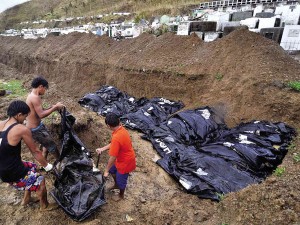
MASS BURIAL Policemen and volunteers bury some 100 bodies in a mass grave in the Tacloban City public cemetery on Thursday. RICHARD A. REYES
TACLOBAN—Clouds of flies rise as forensic pathologist Cecilia Lim opens body bags one-by-one, in a grim but crucial search for the identities of unknown typhoon victims in the Philippines.
“Some of these remains, their faces are gone. We’re trying to do it as fast as we can before we lose everything,” says Lim, as a truck unloads 80 more dead at her workspace—the edge of a mass grave outside the storm-shattered city of Tacloban.
A putrid stench rises from the giant pit where around 700 unevenly stacked bodies lie six deep, some of them having lain in the tropical heat for a week-and-a-half.
Scores more lie on the side of the road, lined up in bags and awaiting processing by small, overworked teams.
Lim says the aim is to record rudimentary details before they are buried in the hope that at some point, the bodies can be identified and placed in a proper grave.
“We are trying to do some initial victim identification and post mortem gathering of evidence before the bodies really decompose,” she says.
Many were recovered after being submerged for days in pools of water left by the tsunami-like storm surge that crashed into Tacloban when Super Typhoon Haiyan made landfall on November 8.
Logging the dead
As her assistant lifts the limp, wet clothes of each cadaver, Lim takes notes in neat cursive script in a reporter’s notebook, recording the sex and describing distinguishing marks.
Each hand is lifted to check for rings and the pockets are emptied, their contents inspected, logged and photographed.
Long, matted hair is scraped from one woman’s face, exposing her teeth so Lim can take a picture.
Crouching over the bloated body of one man, her knees just above the remains of his face, Lim unfolds a pair of spectacles taken from his shirt pocket, looking for a brand name on the arm before she refolds and photographs them.
“We document the clothes they are wearing, as well as any jewellery, tattoos or scars; something distinctive that people remember,” she says.
Cesar Pretencio rode his motorbike up from Tacloban in the search for his mother’s body.
“We had identified her and she was left in the chapel, but now she is gone,” he says.
“We want to know where she is so we can give her a proper burial.”
Lim nods sympathetically and tells Pretencio she will “keep an eye out” for his mother.
With the disaster known to have left more than 5,500 people dead or missing, the authorities are overwhelmed and Lim is just one of a handful of forensic pathologists who have been called in to help.
Those that are identified can be claimed by family and interred with the usual ceremony. The rest are taken to one of three pits like this.
A grim search
The corpses are brought by firefighters who drive around the ruined city collecting the dead from among the debris of the storm surge.
“Yesterday we went out on the truck around Tacloban picking up bodies. We got 92,” Gallie Encabo tells AFP.
He is part of a group of 15 firemen who have come from the southern island of Mindanao to help with the recovery after one of the most powerful storms ever recorded.
The teams are being rotated among body collection, mass grave duty and water distribution.
“When the doctors have recorded the marks on the bodies for identification, we will put them in the ground,” he says, gesturing to the pit where a yellow excavator is digging a second trench.
This is the first time they have done body recovery on such a scale, says fellow firefighter Edgar Reyes.
“There are so many,” he says. “Yesterday when we stopped for one body, people would be shouting: ‘Hey, there’s one over here’.”
Lim, who trained in Detroit and Singapore, says that since she and other professionals started work on Monday, they have been trying to impose order on the burial process.
“Normal practice in a disaster like this is for the bodies to be buried in a single line, each one numbered so that they can be located easily,” she says.
“But lots of these have just been dumped in on top of one another. That will mean that we could have to dig up a lot of the grave to get at one body.”
Ideally, she says, they would like to do DNA tests so that scientists can match the dead with those looking for them. But the tests are not cheap, and with cadavers in such an advanced state of decay, not straightforward either.
“Because of the state of the bodies, we will have to get DNA samples from bones, and that isn’t easy.”
Despite a long medical career, Lim admits that dealing with so many corpses after a calamity like this is harrowing work.
“You go through all the training for a mass disaster,” she says. “But nothing can prepare you for this.”
Related Stories:
`Yolanda’ death toll now over 4,000
Give cash, Samar lawmaker asks ‘Yolanda’ aid donors
Gov’t eyes P45B fund for ‘Yolanda’ rebuilding